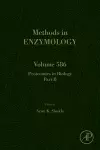
Proteomics in Biology, Part B PDF
Preview Proteomics in Biology, Part B
METHODS IN ENZYMOLOGY Editors-in-Chief ANNA MARIE PYLE Departments of Molecular, Cellular and Developmental Biology and Department of Chemistry Investigator, Howard Hughes Medical Institute Yale University DAVID W. CHRISTIANSON Roy and Diana Vagelos Laboratories Department of Chemistry University of Pennsylvania Philadelphia, PA Founding Editors SIDNEY P. COLOWICK and NATHAN O. KAPLAN AcademicPressisanimprintofElsevier 50HampshireStreet,5thFloor,Cambridge,MA02139,UnitedStates 525BStreet,Suite1800,SanDiego,CA92101–4495,UnitedStates TheBoulevard,LangfordLane,Kidlington,OxfordOX51GB,UnitedKingdom 125LondonWall,London,EC2Y5AS,UnitedKingdom Firstedition2017 Copyright©2017ElsevierInc.Allrightsreserved. Nopartofthispublicationmaybereproducedortransmittedinanyformorbyanymeans, electronicormechanical,includingphotocopying,recording,oranyinformationstorageand retrievalsystem,withoutpermissioninwritingfromthepublisher.Detailsonhowtoseek permission,furtherinformationaboutthePublisher’spermissionspoliciesandour arrangementswithorganizationssuchastheCopyrightClearanceCenterandtheCopyright LicensingAgency,canbefoundatourwebsite:www.elsevier.com/permissions. Thisbookandtheindividualcontributionscontainedinitareprotectedundercopyrightby thePublisher(otherthanasmaybenotedherein). Notices Knowledgeandbestpracticeinthisfieldareconstantlychanging.Asnewresearchand experiencebroadenourunderstanding,changesinresearchmethods,professionalpractices, ormedicaltreatmentmaybecomenecessary. Practitionersandresearchersmustalwaysrelyontheirownexperienceandknowledgein evaluatingandusinganyinformation,methods,compounds,orexperimentsdescribed herein.Inusingsuchinformationormethodstheyshouldbemindfuloftheirownsafetyand thesafetyofothers,includingpartiesforwhomtheyhaveaprofessionalresponsibility. Tothefullestextentofthelaw,neitherthePublishernortheauthors,contributors,oreditors, assumeanyliabilityforanyinjuryand/ordamagetopersonsorpropertyasamatterof productsliability,negligenceorotherwise,orfromanyuseoroperationofanymethods, products,instructions,orideascontainedinthematerialherein. ISBN:978-0-12-809743-4 ISSN:0076-6879 ForinformationonallAcademicPresspublications visitourwebsiteathttps://www.elsevier.com/ Publisher:ZoeKruze AcquisitionEditor:ZoeKruze EditorialProjectManager:HeleneKabes ProductionProjectManager:MageshMahalingam CoverDesigner:MarkRogers TypesetbySPiGlobal,India CONTRIBUTORS C.S.Ang Bio21MolecularScienceandBiotechnologyInstitute,UniversityofMelbourne,Parkville, VIC,Australia J.Armengaud CEA,DRF,IBiTec-S,SPI,Li2D,Laboratory“InnovativeTechnologiesforDetection and Diagnostics”,Bagnols-sur-Ce`ze,France J.V.Arrington PurdueUniversity;PurdueUniversityInstituteforIntegrativeNeuroscience,Purdue University,WestLafayette,IN,UnitedStates K.Baerenfaller ETHZurich,Zurich,Switzerland M.S.Baker FacultyofMedicineandHealthSciences,MacquarieUniversity,NorthRyde,NSW, Australia T.Bonaldi EuropeanInstituteofOncology,Milano,Italy S.Brooks UniversityofAlabama,Tuscaloosa,AL,UnitedStates M.Bui ChromatinStructureandEpigeneticMechanismsUnit,LaboratoryofReceptorBiology and GeneExpression,CCR,NCI,NIH,Bethesda,MD,UnitedStates J.H.Caufield CenterfortheStudyofBiologicalComplexity,VirginiaCommonwealthUniversity, Richmond,VA,UnitedStates E.S.-W.Chen InstituteofBiologicalChemistry,AcademiaSinica,Taipei,Taiwan E.Chevet InsermERL440Oncogenesis,Stress,Signaling,Universit(cid:1)edeRennes1;CentredeLutte ContreleCancerEuge`neMarquis,Rennes,France Y.Dalal ChromatinStructureandEpigeneticMechanismsUnit,LaboratoryofReceptorBiology and GeneExpression,CCR,NCI,NIH,Bethesda,MD,UnitedStates C.Duport SQPOV,UMR0408,AvignonUniversit(cid:1)e,INRA,Avignon,France A.Economou KULeuven,RegaInstituteforMedicalResearch,LaboratoryofMolecularBacteriology, Leuven,Belgium;IMBB-FoRTH,Iraklio,Greece xiii xiv Contributors B.A.Garcia EpigeneticsProgram,PerelmanSchoolofMedicine,UniversityofPennsylvania, Philadelphia,PA,UnitedStates N.J.Garg UniversityofTexasMedicalBranch;InstituteforTranslationalSciences;Institute for HumanInfectionsandImmunity,UniversityofTexasMedicalBranch,Galveston,TX, UnitedStates N.Gupta FromtheChromatinBiologyLaboratory,MolecularBiologyandGeneticsUnit,Jawaharlal NehruCentreforAdvancedScientificResearch,Bangalore,India A.Hashiguchi FacultyofMedicine,UniversityofTsukuba,Tsukuba,Japan J.Heierhorst St.Vincent’sInstituteofMedicalResearch,TheUniversityofMelbourne,Fitzroy,VIC, Australia N.C.Hoch St.Vincent’sInstituteofMedicalResearch,TheUniversityofMelbourne,Fitzroy,VIC, Australia C.-C.Hsu PurdueUniversity,WestLafayette,IN,UnitedStates Z.-C.Hua TheStateKeyLaboratoryofPharmaceuticalBiotechnology,CollegeofLifeSciences, NanjingUniversity,Nanjing,China K.A.Janssen EpigeneticsProgram,PerelmanSchoolofMedicine,UniversityofPennsylvania, Philadelphia,PA,UnitedStates R.Jones MSBioworks,LLC,Annarbor,MI,UnitedStates T.J.D.Jørgensen UniversityofSouthernDenmark,OdenseM,Denmark S.Komatsu NationalInstituteofCropScience,NARO,Tsukuba,Japan G.Lauc GenosGlycoscienceResearchLaboratory;FacultyofPharmacyandBiochemistry, UniversityofZagreb,Zagreb,Croatia Y.-M.Lee FacultyofScience,NationalUniversityofSingapore,Singapore Q.Lin FacultyofScience,NationalUniversityofSingapore,Singapore Contributors xv Y.Li ProteomicsFacility,UniversityofIowa,IowaCity,IA,UnitedStates J.Liu KeyLaboratoryofMedicalMolecularVirology(MOE/MOH)andInstitutesofBiomedical Sciences,ShanghaiMedicalCollege,FudanUniversity,Shanghai,PRChina Y.Liu UniversityofMichigan,AnnArbor,MI,UnitedStates J.Mehla CenterfortheStudyofBiologicalComplexity,VirginiaCommonwealthUniversity, Richmond,VA,UnitedStates A.A.Mehus UniversityofNorthDakotaSchoolofMedicineandHealthSciences,UniversityofNorth Dakota,GrandForks,ND,UnitedStates L.N.Mishra FromtheChromatinBiologyLaboratory,MolecularBiologyandGeneticsUnit,Jawaharlal NehruCentreforAdvancedScientificResearch,Bangalore,India M.Miyagi CenterforProteomicsandBioinformatics,CaseWesternReserveUniversity,Cleveland, OH,UnitedStates W.W.Muhonen UniversityofNorthDakotaSchoolofMedicineandHealthSciences,UniversityofNorth Dakota,GrandForks,ND,UnitedStates L.Negroni InstitutdeG(cid:1)en(cid:1)etiqueetdeBiologieMol(cid:1)eculaireetCellulaire(IGBMC),INSERMU964, CNRSUMR7104,StrasbourgUniversity,Illkirch,France E.C.Nice MonashUniversity,Clayton,VIC,Australia A.Nita-Lazar CellularNetworksProteomicsUnit,LaboratoryofSystemsBiology,NIAID,NIH, Bethesda,MD,UnitedStates R.Noberini CenterforGenomicScience,IstitutoItalianodiTecnologia,Milano,Italy A.G.Nuccio CellularNetworksProteomicsUnit,LaboratoryofSystemsBiology,NIAID,NIH, Bethesda,MD,UnitedStates M.Papanastasiou IMBB-FoRTH,Iraklio,Greece S.Pentakota FromtheChromatinBiologyLaboratory,MolecularBiologyandGeneticsUnit,Jawaharlal NehruCentreforAdvancedScientificResearch,Bangalore,India xvi Contributors M.Pope ProteomicsFacility,UniversityofIowa,IowaCity,IA,UnitedStates M.R.S.Rao FromtheChromatinBiologyLaboratory,MolecularBiologyandGeneticsUnit,Jawaharlal NehruCentreforAdvancedScientificResearch,Bangalore,India N.Sakhawalkar CenterfortheStudyofBiologicalComplexity,VirginiaCommonwealthUniversity, Richmond,VA,UnitedStates J.B.Shabb UniversityofNorthDakotaSchoolofMedicineandHealthSciences,UniversityofNorth Dakota,GrandForks,ND,UnitedStates H.-M.Shen YongLooLinSchoolofMedicine;NUSGraduateSchoolforIntegrativeSciencesand Engineering,NationalUniversityofSingapore,Singapore S.Sidoli EpigeneticsProgram,PerelmanSchoolofMedicine,UniversityofPennsylvania, Philadelphia,PA,UnitedStates S.J.Stafford SealyCenterofMolecularMedicine,UniversityofTexasMedicalBranch,Galveston, TX, UnitedStates M.Subramanian UniversityofIowa,IowaCity,IA,UnitedStates R.Summers UniversityofAlabama,Tuscaloosa,AL,UnitedStates J.Svozil ETHZurich,Zurich,Switzerland W.A.Tao PurdueUniversity;PurdueUniversityInstituteforIntegrativeNeuroscience;Purdue UniversityCenterforCancerResearch,PurdueUniversity,WestLafayette,IN, UnitedStates Y.Temel MUMC+;MHeNs,ExperimentalNeurosurgery,MaastrichtUniversity,Maastricht, TheNetherlands I.Trbojevi(cid:1)c-Akmacˇi(cid:1)c GenosGlycoscienceResearchLaboratory,Zagreb,Croatia M.B.Trelle UniversityofSouthernDenmark,OdenseM,Denmark M.-D.Tsai InstituteofBiologicalChemistry,AcademiaSinica,Taipei,Taiwan Contributors xvii A.Tsirigotaki KULeuven,RegaInstituteforMedicalResearch,LaboratoryofMolecularBacteriology, Leuven,Belgium K.C.Tsolis KULeuven,RegaInstituteforMedicalResearch,LaboratoryofMolecularBacteriology, Leuven,Belgium P.Uetz CenterfortheStudyofBiologicalComplexity,VirginiaCommonwealthUniversity, Richmond,VA,UnitedStates I.Ugrina GenosGlycoscienceResearchLaboratory;FacultyofPharmacyandBiochemistry, UniversityofZagreb,Zagreb,Croatia J.Wang TheStateKeyLaboratoryofPharmaceuticalBiotechnology,CollegeofLifeSciences, NanjingUniversity,Nanjing,China;YongLooLinSchoolofMedicine;FacultyofScience, NationalUniversityofSingapore;InterdisciplinaryResearchGroupinInfectiousDiseases, Singapore-MITAllianceforResearch&Technology(SMART),Singapore J.E.Wiktorowicz SealyCenterofMolecularMedicine;InstituteforTranslationalSciences;Institutefor HumanInfectionsandImmunity,UniversityofTexasMedicalBranch,Galveston,TX, UnitedStates Y.K.Wong YongLooLinSchoolofMedicine;FacultyofScience,NationalUniversityofSingapore, Singapore Y.Xie KeyLaboratoryofMedicalMolecularVirology(MOE/MOH)andInstitutesofBiomedical Sciences,ShanghaiMedicalCollege,FudanUniversity,Shanghai,PRChina Y.Yakkioui MUMC+;MHeNs,ExperimentalNeurosurgery,MaastrichtUniversity,Maastricht, TheNetherlands C.L.Yu ProteomicsFacility,UniversityofIowa,IowaCity,IA,UnitedStates C.Zhang BaylorCollegeofMedicine,Houston,TX,UnitedStates J.Zhang YongLooLinSchoolofMedicine,NationalUniversityofSingapore,Singapore;Clinical ResearchInstitute,ZhejiangProvincialPeople’sHospital,Hangzhou,China X.Zhao KeyLaboratoryofMedicalMolecularVirology(MOE/MOH)andInstitutesofBiomedical Sciences,ShanghaiMedicalCollege,FudanUniversity;MicrobiologyLaboratory,Shanghai MunicipalCenterforDiseaseControlandPrevention,Shanghai,PRChina PREFACE Biological and cellular processes are incredibly complex and result from a largenumberofexceptionallywellfine-tunedandinterconnectedindivid- ualevents.Althoughinvestigationoftheseeventsatindividualisticleveland in isolated context typically provides important functional insights, their studyatsystemslevelandinglobalcontextisabsolutelyessentialtodecipher theinnerworkingsofcellularandbiologicalphenomena.Thishasbeenone ofthekeychallengesinthemoderneraofbiology;however,recentsurgeof proteomicsstrategiesandapproacheshavemadeitpossible.Acombination of well-established and continuously evolving proteomics methodologies hasstartednotonlytorevealthemolecularbasisofawholerangeofbiolog- icalphenomenaandregulation,butithasalsoemergedasamajorengineto open new translational and therapeutic opportunities. The field of proteo- mics has evolved exceptionally rapidly in the last decade or so, and it is a monumental task and near impractical to cover every aspect in a couple of book volumes. Therefore, we have made the selection of chapters to cover a range of conventional approaches and well-established platforms, afewrecentbreakthroughswithrespecttodiscoveryofnovelexperimental framework,andfinally,afewchaptershighlightingtheuntappedpotentialof proteomics approaches with a futuristic outlook. Manyoftheproteomicsprotocolshavebeenstandardizedacrossdiffer- ent laboratories and published in many primary research articles, and therefore,theyaremostlyaccessibletoanyinterestedresearcherinthefield. WehaveincludedafewchaptersinthesetwovolumesofMethodsinEnzy- mology that briefly describe routine sample preparation strategies and then focus more on recent modifications that have been tested and validated experimentally. One of the key areas that has immensely benefited from the recent applications of proteomics is the identification, quantitation, and analysis of post-translational modifications such as glycosylation, phos- phorylation,andacetylation.Here,wehavecollectedanumberofchapters describingtheapplicationofproteomicsapproachesinstudyingawiderange ofpost-translationalmodifications,eitherintheformofgenericprotocolsor withaparticularbiologicaltargetasacaseexample.Proteomics-basedstudies typicallygeneratelargebodyofdatawhichononehandrepresentgoldmine forextractingnovelfunctionalinsightsbutontheotherposeamajorchallenge in terms of unbiased, careful, and rigorous analysis. These large proteomics xix xx Preface datasetsofferuniquepossibilitiesasahypothesisgenerationplatformtodesign subsequentexperimentalstrategiestogainnovelfunctionalinsightsintobio- logical processes. Considering that data handling and analysis represents an absolutely critical component in proteomics pipeline, we have included a number of chapters in these two volumes that specifically focus on recent trends in proteomics data analysis and interpretation. Oneofthepowersofproteomicsapproacheshasbeenthepossibilityof studyingthebiologicalprocessesatorganellarandorganismlevels.Thishas openedupthepossibilitiesofobtainingaglobalandholisticviewofbiolog- ical processes in physiologically relevant context instead of in isolation. Anumberofchaptersinthesetwovolumescoverthisaspect,forexample, analysisofbodyfluiddegradomics,globalassessmentofproteinsynthesisin C. elegans, comprehensive analysis of E. coli membrane proteins, and a few others. These chapters underline the robust platform that proteomics can provide for generating important systems-wide clues in biology. Another importantapplicationofproteomics,inadditiontobeingadiscoveryengine for basicbiology,isthatitcanopenupnewpossibilitiesindiseaseetiology and therapeutics, for example, by identifying novel biomarkers or by presenting a comparative proteome-wide view of pathological vs normal tissues. We have incorporated a number of chapters that specifically high- light the power of proteomics-based approaches in disease models such as identificationofnovelbiomarkers,quantitativeproteomeprofilingoftumor tissues, and identifying key aspects of host–pathogen interactions. These chapters categorically underscore the emerging utility of proteomics approaches in translational biology and highlight a frontier where a major focus of the field is headed currently. Itakethisopportunitytosincerelythankalltheauthorsfortheirexcel- lent contributions which have made these two volumes possible. I also express my gratitude to the editorial and production team of Methods in Enzymologyforbeautifullycoordinatingthisproject.Onbehalfoftheentire MethodsinEnzymologyteam,Ipresenttwovolumesentitled“Proteomicsin Biology:PartA”and“ProteomicsinBiology:PartB.”Isincerelyhopethat youfindthecontentofthesetwovolumesextremelyusefulandIwelcome your feedback and comments. With best compliments ARUN K. SHUKLA Indian Institute of Technology, Kanpur, India CHAPTER ONE Protein Cysteinyl-S-Nitrosylation: Analysis and Quantification J.E. Wiktorowicz*,{,§, S.J. Stafford*, N.J. Garg†,{,§,1 *SealyCenterofMolecularMedicine,UniversityofTexasMedicalBranch,Galveston,TX,UnitedStates †UniversityofTexasMedicalBranch,Galveston,TX,UnitedStates {InstituteforTranslationalSciences,UniversityofTexasMedicalBranch,Galveston,TX,UnitedStates §InstituteforHumanInfectionsandImmunity,UniversityofTexasMedicalBranch,Galveston,TX, UnitedStates 1Correspondingauthor:e-mailaddress:[email protected] Contents 1. Introduction 1 2. SNOFloMethodology 3 3. Applications 10 References 13 Abstract Thethiolmoietyofcysteineresiduescanundergoanumberofbiologicmodifications including oxidation, sulfenylation, nitrosylation, persulfidation, metalation, and other modifications. These modifications can control biological function, including gain as well as loss of function. Herein, we focus attention on the proteomic analysis of S-nitrosylationinhealthanddisease.Wedescribeanovelquantitativeapproachthat combinesaccurate,sensitivefluorescencemodificationofcysteinyl-S-nitrosylationthat leaveselectrophoreticmobilityunaffected(SNOFlo),andintroduceuniqueconceptsfor measuringchangesinS-nitrosylationstatusrelativetoproteinabundance.Wepresent several studies where suitability of this approach for investigating endogenous S-nitrosylationisaddressed. 1. INTRODUCTION It is currently estimated that the human genome consists of some 20,700+ genes (GENCODE 19). In contrast, with posttranscriptional processing (e.g., alternative splicing, RNA editing) and posttranslational modifications, there are likely to be over 1M “proteoforms” (defined in Smith, Kelleher, Consortium for Top Down Proteomics, 2013) in the human cell. These molecular events occur ubiquitously (pun intended) MethodsinEnzymology,Volume586 #2017ElsevierInc. 1 ISSN0076-6879 Allrightsreserved. http://dx.doi.org/10.1016/bs.mie.2016.10.016
